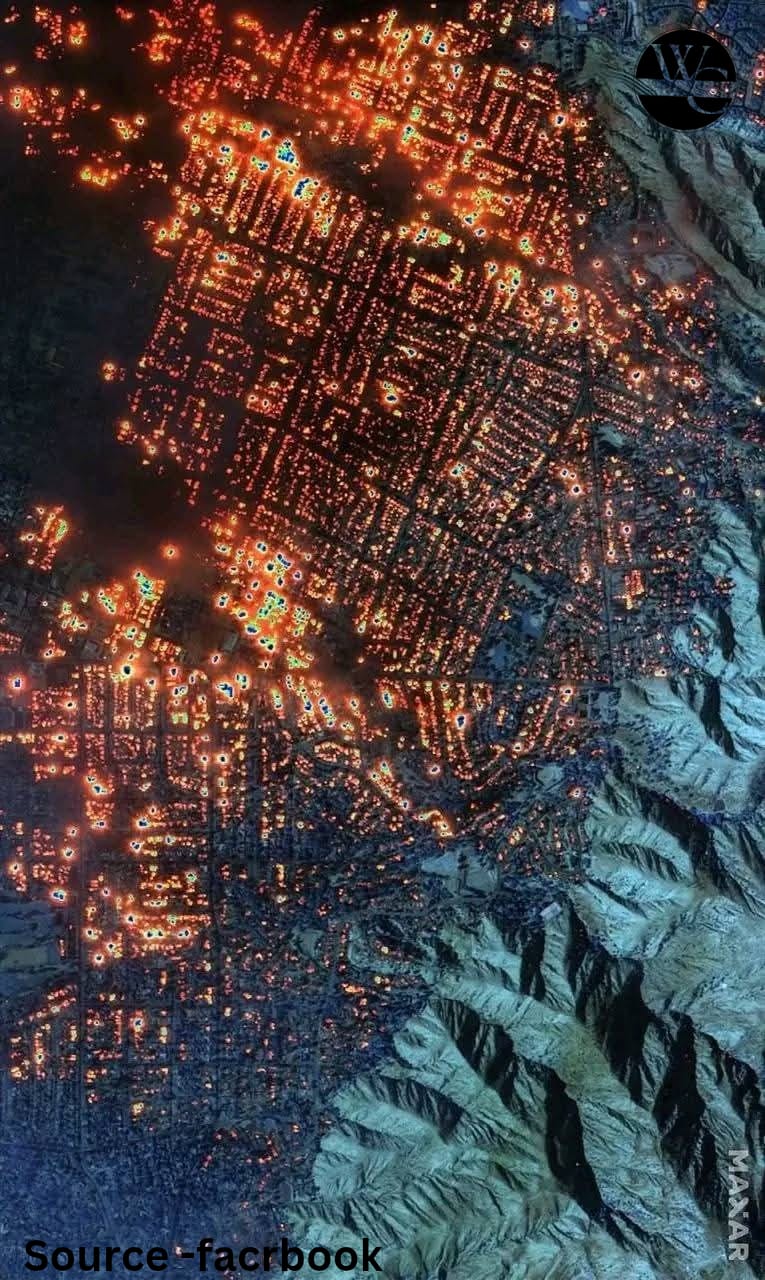As the relentless effects of climate change continue to impact the United States, wildfires have become a growing concern, particularly in areas like Los Angeles.
Large Wildfires Burn in Los Angeles, Forcing Mass Evacuations: Latest Updates
In 2025, large wildfires are currently burning across the city, prompting widespread evacuations and putting residents on edge. These fires are part of an increasing trend of extreme weather events that threaten the safety, infrastructure, and environment of one of California’s largest metropolitan areas.
Pele| The Magical King of Football| Black Pearl
The Growing Wildfire Threat in Los Angeles
In recent days, wildfires in Los Angeles have intensified, fueled by high temperatures, strong winds, and dry vegetation. This is not an isolated event. California has faced increasingly severe wildfire seasons over the past decade, exacerbated by drought conditions and urban sprawl encroaching on fire-prone areas. As of January 2025, multiple wildfire zones in Los Angeles have been designated as critical risk areas.
Firefighters, emergency response teams, and local authorities have been working tirelessly to combat these dangerous wildfires while trying to prevent further damage to homes and businesses. While some fires have been contained, others continue to burn uncontrollably, leading to mass evacuations and creating serious challenges for local resources.
Why Are Wildfires So Dangerous in Los Angeles?
The wildfires in Los Angeles are especially concerning because of the combination of dry conditions, high winds, and densely populated areas. Many of the fires have been fueled by Santa Ana winds, which are notorious for spreading flames quickly and making firefighting efforts more difficult. These winds can drive wildfires into populated areas in a matter of hours, leaving little time for evacuation.
Moreover, wildfire smoke can create health risks for residents far from the flames. Air quality in Los Angeles often reaches hazardous levels during wildfire events, leading to respiratory issues and exacerbating pre-existing health conditions like asthma.
Key Areas Affected by the Fires
In Current Situation Economic ,Political & Social Impact of U S government Shutdown
The wildfires in Los Angeles have spread across several key areas, including Malibu, Calabasas, and Simi Valley, all of which have been placed under evacuation orders. These areas are known for their high-end real estate and proximity to dense forests and rugged terrain, making them especially vulnerable to wildfires.
- Malibu: This coastal city is famous for its luxury homes and beautiful scenery but is also prone to wildfires due to the dry conditions in the region.
- Calabasas: A suburban area with a mix of residential homes and expansive open spaces, this region has seen flames spread rapidly due to winds.
- Simi Valley: Known for its proximity to the Santa Susana Mountains, this area has been directly impacted by the encroaching fires, prompting local authorities to issue urgent evacuation notices.
In addition to these well-known neighborhoods, other parts of Los Angeles, including the San Fernando Valley and Ventura County, are also at high risk. Emergency shelters have been set up across the region to accommodate evacuees and provide basic necessities like food, water, and medical assistance.
Forced Evacuations and the Impact on Residents
As of the latest updates, the evacuations in Los Angeles have impacted thousands of residents. Fire evacuation orders have been issued in several communities, with thousands of people being forced to leave their homes and seek shelter in safer areas. The urgency of the situation is compounded by the unpredictable nature of the fires, making it difficult for authorities to determine when it will be safe for residents to return.
For many Los Angeles residents, these wildfires are an alarming reminder of the increasing frequency and severity of natural disasters. With homes and lives at risk, many families are scrambling to find shelter and safety. Local authorities, including the Los Angeles Fire Department (LAFD), are working alongside state agencies to ensure that the evacuations are carried out swiftly and effectively.
In addition to the physical toll of evacuations, the mental health impact of these wildfires is becoming evident. Many residents are dealing with stress, anxiety, and trauma as they watch their homes and neighborhoods burn. Additionally, emergency responders are working long hours under high stress, further highlighting the emotional and psychological strain these fires cause.
The Role of Climate Change in Increasing Wildfire Frequency
Experts agree that climate change plays a significant role in the increasing frequency and severity of wildfires across California, including Los Angeles. Rising temperatures, prolonged droughts, and increasingly erratic weather patterns are creating perfect conditions for wildfires to thrive. Global warming has dried out vegetation, making it more susceptible to ignition, while increased air temperatures accelerate fire growth.
In Los Angeles, urbanization has also contributed to the problem, with wildland-urban interface areas becoming more common. These are zones where dense human populations live in close proximity to natural forests, making it difficult to prevent wildfires from spreading to homes and businesses.
Wildfire Response Efforts: Firefighters on the Front Lines
Firefighting crews have been working tirelessly to battle the wildfires in Los Angeles. Local and state agencies, including the California Department of Forestry and Fire Protection (CAL FIRE), have mobilized resources to contain the flames. Thousands of firefighters have been deployed, working in shifts to maintain a constant presence at fire fronts.
To assist in containing the fire, additional air support is being provided, including water-dropping helicopters and air tankers that release fire retardant. However, despite these efforts, the rapid spread of the fires, combined with the challenges posed by steep terrain and dry conditions, has made it difficult to fully contain the blazes.
The LAFD has also issued safety guidelines for residents and evacuees, advising them to stay away from fire-prone areas, follow evacuation orders promptly, and remain alert to air quality warnings. The agency has emphasized the importance of remaining calm and informed during these uncertain times.
Looking Ahead: Managing Wildfire Risk in Los Angeles
As wildfires continue to threaten Los Angeles, local authorities are focusing on both short-term and long-term solutions to mitigate risk. Efforts are being made to improve fire resilience in urban areas, including firebreaks (cleared zones of vegetation) and stronger building codes that incorporate fire-resistant materials.
Moreover, officials are calling for increased investment in wildfire management strategies that address the root causes of fire risks, including forest management and more aggressive steps to combat climate change. Reducing carbon emissions and implementing sustainable practices in urban planning will be crucial in preventing future wildfires from becoming more frequent and severe.
Conclusion: The Ongoing Challenge of Wildfires in Los Angeles
As wildfires burn in Los Angeles, the urgency for comprehensive action to address both the immediate and long-term challenges of wildfire management is clear. With thousands displaced and emergency response teams working around the clock, Los Angeles residents face an uncertain future as they deal with the immediate impacts of these destructive fires.
While authorities and firefighters continue their efforts to control the situation, the increasing frequency of wildfires in California is a stark reminder of the challenges posed by climate change. For now, evacuations remain in place as the battle against these fires continues, and residents anxiously await updates on their homes and communities.
In the coming weeks, the focus will shift toward recovery, rebuilding, and reevaluating the city’s approach to mitigating future wildfire threats. Until then, Los Angeles is bracing for what could be a longer, more devastating fire season.
What causes wildfires in Los Angeles?
Wildfires in Los Angeles are caused by dry conditions, high winds, and extreme temperatures, exacerbated by climate change.
How is climate change linked to wildfires in California?
Climate change increases temperatures, droughts, and dry vegetation, creating ideal conditions for more frequent and severe wildfires in California.
How can residents stay safe during wildfires?
Residents should follow evacuation orders, stay informed, avoid smoke, and prepare emergency kits with essentials for quick evacuation.
What areas in Los Angeles are affected by wildfires?
Malibu, Calabasas, Simi Valley, and the San Fernando Valley are key areas impacted by the ongoing wildfires.
How are evacuations handled during wildfires?
Evacuations are managed by local authorities, issuing orders for residents to leave areas at risk and seek shelter elsewhere.


1 thought on “Large Wildfires Burn in Los Angeles”